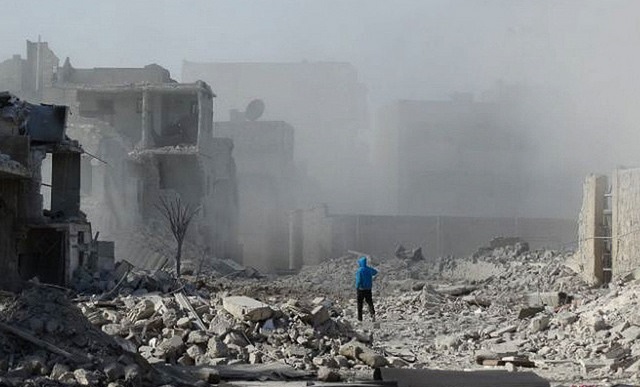 In the summer of 2012, International Security (Vol. 37) published an essay by Professor Richard Pape entitled, “When Duty Calls: A Pragmatic Standard of Humanitarian Intervention.” Pape argued that the genocidal standard for humanitarian intervention was too high. The norm itself “puts the international community in a catch-22: by the time it is clear that a genocide is occurring, it is often too late to stop the killing.” Pape’s standard—pragmatic humanitarian intervention—would require three things: an ongoing campaign of mass homicide; a viable plan for intervention entailing low or no casualties by those intervening; and “a workable strategy for creating lasting local security, so that the saving of lives in the short-term does not lead to open-ended chaos in which many more are killed in the long-term.” In 2012 Professor Pape concluded that Syria did not meet the standard. It is argued here that in 2014 it does.
In the summer of 2012, International Security (Vol. 37) published an essay by Professor Richard Pape entitled, “When Duty Calls: A Pragmatic Standard of Humanitarian Intervention.” Pape argued that the genocidal standard for humanitarian intervention was too high. The norm itself “puts the international community in a catch-22: by the time it is clear that a genocide is occurring, it is often too late to stop the killing.” Pape’s standard—pragmatic humanitarian intervention—would require three things: an ongoing campaign of mass homicide; a viable plan for intervention entailing low or no casualties by those intervening; and “a workable strategy for creating lasting local security, so that the saving of lives in the short-term does not lead to open-ended chaos in which many more are killed in the long-term.” In 2012 Professor Pape concluded that Syria did not meet the standard. It is argued here that in 2014 it does.
When he wrote his article Pape examined a Syrian conflict he characterized as regime security forces killing civilian protesters. His assessment—as of April 2012—was that, in one year’s time, Assad regime forces had killed 8,000 civilians, compared with 2,000 killed in Libya over the course of only one month. “In short,” according to Pape, “the most reasonable assessment is that the Syrian government is engaging in a ‘slow motion’ mass homicide campaign, which could easily lead to more deaths, albeit on a smaller scale than in Libya.”
Given that mass homicide in Syria was still largely a matter of urban protesters set upon by regime forces, Pape correctly concluded that “air power alone would probably be insufficient to blunt Syrian security forces against the protests…” Indeed, those security forces were operating in cities where the regime had considerable support, largely from minority communities. The Syrian opposition, by way of contrast, had physical control over very little that was separable from regime-controlled areas. So an air campaign—the kind that would produce few or no casualties among the interveners (as was the case in Libya)—was deemed by Pape in the spring of 2012 to be a nonstarter in Syria.
Finally, Pape saw no prospect of humanitarian intervention producing an enduring security strategy for Syria. His reasoning was unassailable: “Absent viable military options to safeguard Syrian protesters from the Assad government in the short term, it is hardly surprising that there have been no credible proposals to provide lasting security for them… [D]espite the slow-motion mass homicide campaign that is under way, there is at present no means to stop it without unacceptable loss of life among the interveners and with viable prospects of enduring security for the targeted population.”
Pape’s reasoning in the first half of 2012 corresponded to the unanimous view of senior United States government officials at the time. In early 2012, Kofi Annan’s United Nations monitors were trying and failing to interpose themselves between regime assailants and their victims. Nowhere in the US government was there any sentiment for arming those monitors or intervening militarily—not in the spring of 2012.
As spring turned to summer, however, views began to change. The decision of Russia to dishonor its signature on the Geneva Final Communiqué, the thorough militarization of the conflict, the taking of territory (including urban areas) by armed opposition elements, and the move by the Assad regime to speed up slow-motion homicide by concentrating artillery, aircraft, rockets, and missiles indiscriminately against rebel-held civilian neighborhoods, altered the ground situation fundamentally. By mid-2012, the conditions that had impelled Professor Pape to conclude that Syria was not a candidate for pragmatic humanitarian intervention had changed dramatically.
It was not, however, until August 2013 that the Obama administration gave serious thought to a humanitarian military intervention in Syria. Pape makes an important point in his essay: to the extent other interests creep into the calculus, intervention becomes something other than humanitarian in nature. In the summer of 2012, for example, President Barack Obama’s key national security lieutenants perceived a growing al-Qaeda presence in Syria and a regime willing to sink the neighborhood to stay alive: they recommended significant arming, training, and equipping of the Free Syrian Army. The president rejected the recommendation: one that was not humanitarian in nature. A year later, however, he was confronted by rows of asphyxiated Syrian children, slaughtered in a regime chemical assault. He may have thought about the policy consequences of a red-line crossed for perhaps the fourteenth time. But his instinct was to save lives. It was, for President Obama, inadmissible that lives should be lost to chemical weaponry. After considering a kinetic response to the Assad regime, the president settled for an agreement that would remove from Syria the offending munitions and neutralize the regime’s ability to produce them.
Is Syria today a candidate for pragmatic humanitarian intervention consistent with the Pape criteria? So it appears. A review of the criteria in the light of conditions changed fundamentally since the spring of 2012 makes the case.
First is something that has not changed: the Syrian regime is still engaged in a program of mass homicide. Indeed, there is no longer anything “slow motion” about it. The reporting of the independent international commission of inquiry to the United Nations Human Rights Council is dispositive. Assad and his lieutenants will be subject to full legal accountability for war crimes and crimes against humanity for as long as they live.
Second, regime gunmen have in fact been expelled from many populated parts of Syria. It is no longer a matter of regime snipers picking off protesters in contested city streets. As the commission of inquiry has reported repeatedly, the regime’s tactic of choice is to bring massed fires from artillery, aircraft, rockets, and missiles to bear indiscriminately on populated areas beyond its control. This is a tactic steeped in criminality. More to the point, however, the manner of assault offers discrete targets for potential interveners exclusively employing air strikes: artillery formations (deployed and in rear areas); military aircraft and associated airfields; and missiles and rockets, both deployed and in storage areas. Although no military operation can assume the absence of casualties, a combination of stand-off weaponry and stealth systems would presumably reduce risk considerably.
Pape’s third criterion, however, offers grist for debate. Destroying or significantly mitigating the Assad regime’s ability to conduct mass homicide through massed fires would not produce—in a formal sense—”enduring security for the targeted population.” Yes, wholesale slaughter from afar would be eliminated or mitigated. No, massacres of civilians by regime gunmen able to gain ground access to vulnerable populations might not be preventable. And no, there would be no guarantee that Tehran and Moscow would not resupply their client over time to enable the resumption of especially lethal war crimes and crimes against humanity. Life-saving intervention might have to occur more than once.
Still, on balance, Syria today meets the criteria for pragmatic humanitarian intervention offered in early 2012 by Professor Pape. Clearly President Obama thought it did so as recently as September 2013. If anything, the regime’s campaign of mass homicide has intensified since then.
Frederic C. Hof is a resident senior fellow with the Atlantic Council’s Rafik Hariri Center for the Middle East.
Image: (Photo: Flickr/FreedomHouse)

